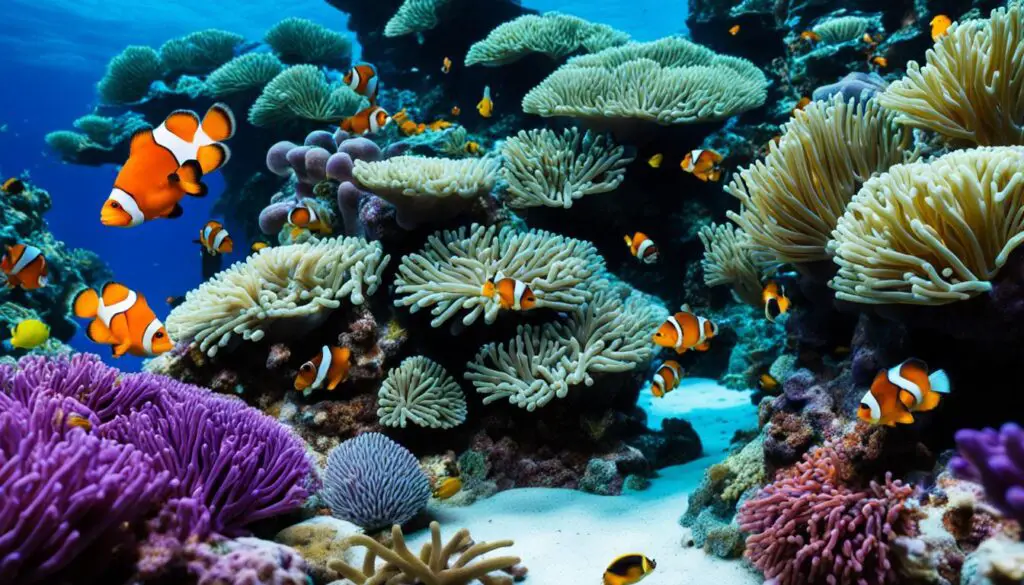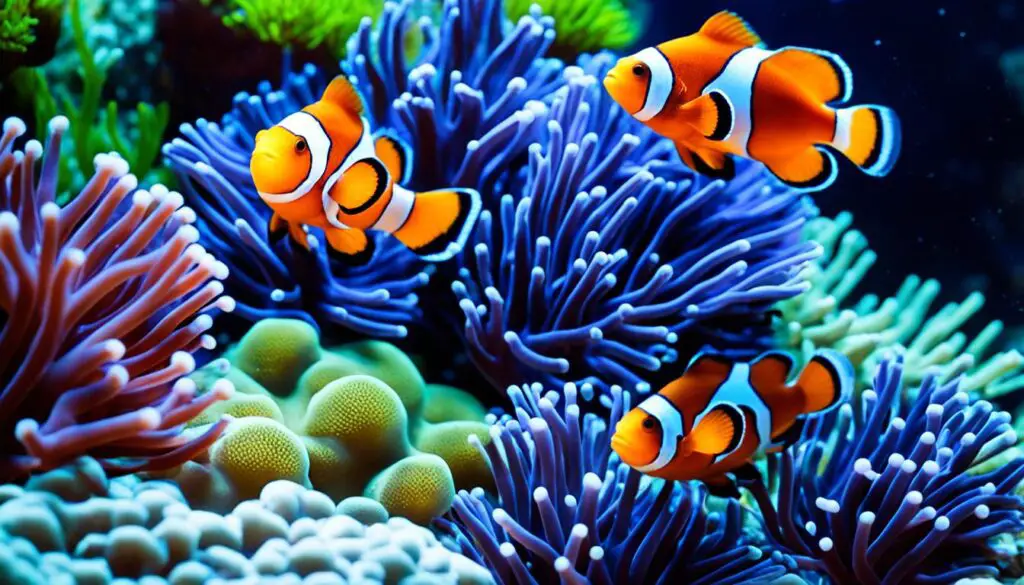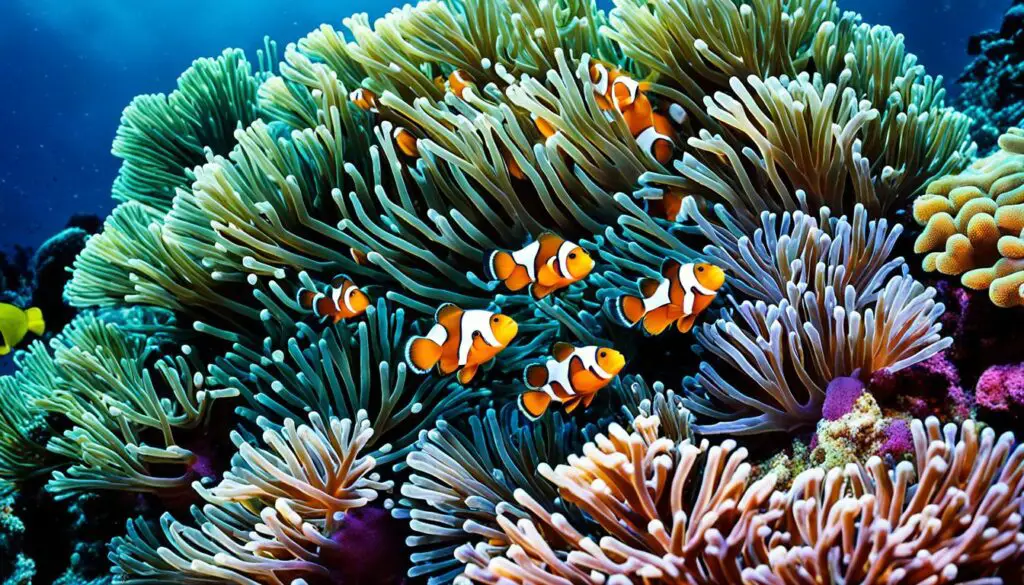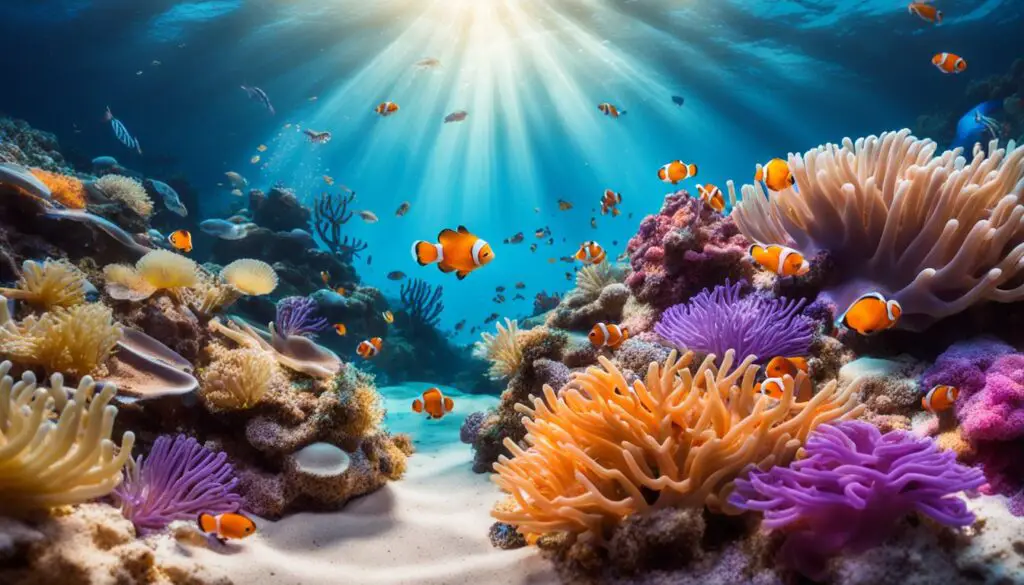The Ecosystem of Clownfish: Dive into Their Natural World

Clownfish are known for their beautiful looks and interesting ways. There are more than 30 kinds of clownfish, each unique. They live in the Red Sea, Indian Ocean, and the Western Pacific. They like being in shallow lagoons and safe coral reefs. Clownfish eat tiny plants and animals.
Clownfish and some anemones help each other out. This helps the clownfish stay safe and get food from the anemone. The clownfish also clean the anemones. This special team-up is great for both. Only a few anemones, around 10, can protect the clownfish from getting stung. This saves the clownfish and the anemones from harm.
But, these fish are in danger from changes in the climate and ocean. These changes can confuse them so they can’t find their way. They also find it hard to spot dangers. We need to help protect these amazing creatures. We have to fight against these environmental issues.
Key Takeaways:
- Clownfish are a diverse group of species, with over 30 recognized species.
- They primarily inhabit the Red Sea, Indian Ocean, and Western Pacific.
- Clownfish have a symbiotic relationship with certain species of anemones.
- Only about 10 out of over 1,000 anemone species are suitable hosts for clownfish.
- Climate change and ocean acidification are threats to clownfish populations.
Clownfish Species and Their Natural Habitats
Clownfish live across the Indian Ocean and the Pacific Ocean. They are in places like the Red Sea and the Great Barrier Reef. These are big, beautiful areas.
Clownfish like to stay in shallow places around reefs. They are friends with certain anemones. These friends protect them and give them a home.
Now, let’s learn about some famous clownfish:
- Ocellaris Clownfish is in the eastern Indian Ocean and western Pacific. It’s known for its bright orange look. Aquarium fans love it.
- True Percula Clownfish lives in shallow areas off the northwest coast of Australia, Japan, and Southeast Asia. It has a vivid orange body with thick black stripes.
- Maroon Clownfish is seen from the western Pacific to Japan and northern Australia. It has deep red color with white bands.
- Pink Skunk Clownfish lives in deeper water. It’s found off the western and eastern coasts of Australia and southern Japan. It stands out with its soft pink color.
Each kind of clownfish likes different places and spaces. But they all need anemones. Anemones are important for their life and health.

Protecting Clownfish and Their Coral Ecosystems
Clownfish and their homes, the coral reefs, are under threat. They face dangers like pollution and changing climates. These risks can harm the clownfish and their living spaces. Without healthy coral, the clownfish can lose their homes and safety found with anemones.
The trade in aquarium fish is also a problem. It can damage populations when done unsustainably. It’s important that we stop overfishing and illegal catching. We must also work to make our daily actions more eco-friendly. This includes supporting efforts to take care of fish habitats and ensuring fishing is done in a way that doesn’t harm the ecosystem.
To save the clownfish and their homes, we can make a difference. We must do what we can to protect the coral. Our choices every day can help. By doing this, we not only protect the ocean’s beauty but also look after the homes of the amazing clownfish.
FAQ
How many species of clownfish are there?
There are over 30 recognized species of clownfish.
Where do clownfish primarily inhabit?
Clownfish mainly live in the Red Sea, Indian Ocean, and Western Pacific.
What do clownfish eat?
Clownfish are omnivores, eating plankton, algae, and small invertebrates.
What is the symbiotic relationship between clownfish and anemones?
Clownfish and anemones have a team-up that benefits both. Anemones protect the clownfish and give them food. The clownfish, in return, keep the anemones healthy by removing parasites and dead parts. This partnership is essential for the lives of both species.
How many anemone species are suitable hosts for clownfish?
Only about 10 out of over 1,000 anemone species are good homes for clownfish.
What threats do clownfish face?
Clownfish are threatened by climate change and ocean acidification. This can mess with their ability to find their way and spot predators.
How can we protect clownfish and their habitats?
We should act to reduce pollution and fight climate change with sustainable methods. Also, backing marine protected areas and safe fishing can help save clownfish and their homes.



